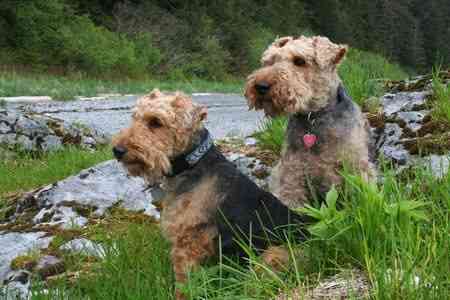- Small Dog Place Home
- A to Z Breed List
- Welsh Terrier
All About the Welsh Terrier
~Playful, Intelligent, Active~
Welsh Terrier by Janice Jones |Published 12-1-2022
Considering a Welsh Terrier? They are a breed above the rest when it comes to their intelligence, playfulness and high-spirited nature.
Calmer than most terrier breeds, these dog’s are sensitive, if not independent, mild mannered, but with a mischievous streak, an uncanny ability to keep you entertained, and a great family dog for anyone with children.

They are
loyal and devoted to their family, a great watch dog, and enjoy water, digging, and a lively conversation. Don't however, expect these dogs to offer any sort of protection.
They may be somewhat wary of strangers, but they often forget this initial shyness and enjoy anyone who seems eager to make their acquaintance.
Quick Facts
Other Names Used: Welshie
Affiliation: Terrier Group with the AKC, ANKC, CKC, FCI, KC, NZKC, UKC
Size
Height: 15 inches, (39 centimeter)
Weight: 20-21 pounds, (9-9.5 kilograms)
Coat Type: Hard, Wiry, Dense or Broken Coat. There is a short soft undercoat
Colors: Black and Tan, Grizzle and Tan, Black Grizzle and Tan
Country of Origin: Wales
Activity Level: Moderately Active
Life Expectancy: 12-15 years
Good with Children: YES
Good with other pets: Not good with small pocket pets; Maybe quarrelsome with other dogs
History

The Welsh Terrier is only one of two terrier breeds native to Wales and was popular in Britain in the 18th and 19th centuries. Though they look like miniature Airedale Terriers, they are a distinct breed.
While the Airedale was being developed in northern England from dogs known as the Old English Broken-Haired.
In Northern Wales, a different strain, know as the Ynysfor. Though separated by geography, both could be indistinguishable from the other, both being developed to hunt otter, fox, and badger.
Eventually, though, they were separated into different breeds and then further developed. In many ways, the Welsh Terrier looks like a miniature Airedale Terrier.
The breed was first shown to the country of England in 1884, and thanks to Prescott Lawrence, the breed was brought to America in 1888, which is the same year they were accepted into the American Kennel Club.
In 2015, they ranked 112 the in popularity with the AKC out of 184 listed breeds.
The Breed's Traits
| Traits | Rating |
|---|---|
| Playfulness | |
| Affection Level | |
| Friendliness Towards Strangers | |
| Good with Children | |
| Good with Other Dogs | |
| Good for First Time Owners | |
| Exercise Needed | |
| Ease of Training | |
| Watch Dog Ability | |
| Grooming Requirements | |
| Shedding | |
| Cold Tolerant | |
| Heat Tolerant |
Dog Breed Ratings Got You a Little Confused?
Here's a little help in understanding them
- Playfulness: Most Playful = 5 Least Playful = 1
- Affection: Most Affectionate = 5 Least Affectionate = 1
- Friendliness Towards Strangers: Most Friendly = 5 Least = 1
- Good With Children: Great= 5 Not Good with Children = 1
- Good With Dogs: Great = 5 Not Good Around Dogs = 1
- Good With First Time Owners: Fine=5 Not Appropriate = 1
- Exercise Required: Extensive Daily Exercise = 1 Minimal = 1
- Ease of Training: Very Easy = 5 Difficult = 1
- Watch Dog: Excellent Watchdog = 5 Minimal = 1
- Grooming: Time Consuming = 5 Minimal = 1
- Shedding: Heavy Shedder = 5 Minimal = 1
- Cold Tolerance: Well Tolerated = 5 Poor Tolerance = 1
- Heat Tolerance: Well Tolerated = 5 Poor Tolerance = 1
Personality
Although the Welsh Terrier may look similar to the Airedale Terrier in physical appearance, do not let that fool you into thinking they have similar personalities.
Many believe that this terrier is one of the easiest trained and docile of all the terrier breeds. That doesn’t mean that you’ll have a couch potato willing to keep your lap warm. They are still Terrier, through and through.
Training requires an active, fun approach and consistency. Like many small breed dogs, the Welsh Terrier can be difficult to house-train. Food rewards and playtime work very well with these dogs.

This is an independent breed that is not always sure that pleasing his owner is in his best interest. But, you can get around this.
It may be a difficult breed for a first-time dog owner to take on, especially because they require a bit more maintenance than your average dog.
Experienced dog owners can find these dogs to be a fun challenge.
The Welsh Terrier is a very smart and independent dog because they were originally bred for independent hunting of small animals.
Something unique to the Welsh, as they are often called, is that they crave challenges, never backing down if the need arises. If people don’t provide the challenge, the Welsh Terrier will find one on their own, not always to the liking of the owner.
They love to run around and dig and they require an hour of vigorous exercise daily at the very least. This is not a breed of dog for someone who does not live a very active lifestyle.
Without the proper time to get all their energy out, your Welshie may become bored and possibly even aggressive, which is not what you want.
With proper training and exercise, you will have a friendly, spirited, canine friend for life. They do best with an owner that uses a consistent, positive approach to training. Socialization should begin the moment you bring your new puppy home.
Another great thing about the Welsh Terrier is that they are good with children. While other breeds of dogs don’t particularly love being roughhoused by young children, Welshies absolutely love it and don’t mind it your kids are a little rough with them. They are playful and affectionate and seem to crave the attention they receive from children.
They also get along well with other dogs if socialized at a young age. It is important that this breed is trained and socialized very young to keep them in check as adults, especially considering their independent and stubborn nature.
Some pets such as pocket pets don’t do well at all with this breed due to the Welshies strong prey drive. Their natural instinct to hunt will make it tough for them to get along with your small pets.
They can live in apartments, but because they make excellent watch dogs, they may end up barking at every suspicious noise which close neighbors will find annoying.
Socialization is vital to all puppies, but these dogs will do very well if they are trained and socialized from an early age. They are active, so they require a daily walk on the leash.
These dogs should not be left off leash and even an electronic fence may not adequately protect them if they happen to see something small that catches their attention.
Welsh Terriers have performed well in a variety of dog sports such as earth dog trials, agility, and even obedience.
Had to share this video because it makes training a Welsh Terrier Look very easy. What do you think?
Grooming the Welsh Terrier

The good news is that this is a light to the non-shedding dog, which is ideal for those who have allergies.
They do require a fair amount of grooming and maintenance to maintain their beautiful coat. Brushing their hair every other day will keep it in good shape, and typical of most terriers, they should also be stripped or clipped about ever 3 to 4 months.
Not every terrier owner opts for hand-stripping because it is time-consuming to do yourself and expensive to hire a groomer.
Hand stripping is the process of grabbing the outer hairs by pulling them out you’re your fingers or a stripping knife. First of all, don’t panic, most of the hair that are removed is dead which is not nearly as painful as you might think. It helps to remove the excessive hair which works well in the summer when the temperature.
They also need regular baths to keep them looking clean and smelling fresh. Their teeth should regularly be brushed and their ears checked and cleaned if needed.
Toenails should also be clipped about every two to three weeks. You will know when they are too long if you hear them click on a hard floor.
Using a nail grinder is also an option if your dog hates to have his nails clipped. Using the grinder or a metal file after clipping will smooth them out so no one can get scratched from frayed nail ends.
Health Concerns
The Welsh Terrier is a healthy breed but like any other dog breed, they have been known to inherit certain genetic problems.
These following problems have been identified in the breed. These diseases are common to all dogs, large and small. Just because they have been recognized in this breed does not mean your Welsh Terrier will have any.
It is still a good idea to know what health problems have been identified in this breed:
and some minor eye and skin diseases
Purchasing a Welsh Terrier from a reputable breeder who does some health screens on their adult dogs will assure you that you are getting a healthy dog. Genetic testing has become more commonplace so ask the breeder what tests have been done.
Pros
- Relative low shedding dogs that are good for allergy sufferers
- Watchdog ability is excellent, but don’t expect to be protected
- Entertaining, playful, fun family dog
- Great with children
- Relatively Healthy breed
Cons
- Requires a patient owner to achieve obedience training
- Fairly high maintenance in the form of grooming
- Will need an owner willing to provide necessary exercise for his activity needs
- May be hard to housebreak
- Less common than other breeds; may make finding one more challenging
Did You Know ?
John F. Kennedy owned a Welsh Terrier named Charlie
King Edward VIII owned a Welsh Terrier named Gwen
For Welshie Lovers
About Janice (author and voice behind this site)
Having lived with dogs and cats most of her life, Janice served as a veterinary technician for ten years in Maryland and twelve years as a Shih Tzu dog breeder in Ohio.
Her education includes undergraduate degrees in Psychology with a minor in biology, Early Childhood Education, and Nursing, and a master's in Mental Health Counseling.
She is a lifelong learner, a dog lover, and passionate about the welfare of animals. Her favorite breed for over 50 years has been the Shih Tzu, but she has also lived with Poodles, Maltese, Yorkshire Terriers, Beagles, English Bulldogs, Carin Terriers, and a Cocker Spaniel.
When not writing, reading, and researching dog-related topics, she likes to spend time with her eight Shih Tzu dogs, husband, and family, as well as knitting and crocheting. She is also the voice behind Miracle Shih Tzu and Smart-Knit-Crocheting
Does This Article Deserve Your Thumbs Up?
We always appreciate your support and encouragement. Your thumbs up means so much to us. Please like this article.
If you find this page or any page on Small Dog Place Helpful, or useful in anyway, I'd love it if you would click the small heart found on the bottom right of each page.
You can also share or bookmark this page -- just click on the:

Free Monthly Newsletter
Sign Up for Our Free Newsletter and get our Free Gift to You.
my E-book, The Top 10 Mistakes People Make When Choosing a Dog (and how to avoid them)


